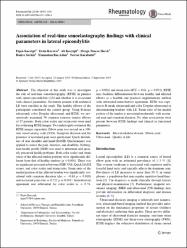| dc.contributor.author | Koçyiğit, Figen | |
| dc.contributor.author | Kuyucu, Ersin | |
| dc.contributor.author | Koçyiğit, Ali | |
| dc.contributor.author | Herek Tuncer, Duygu | |
| dc.contributor.author | Şavkın, Raziye | |
| dc.contributor.author | Aslan Baş, Ümmühan | |
| dc.contributor.author | Karabulut, Nevzat | |
| dc.date.accessioned | 10.07.201910:49:13 | |
| dc.date.accessioned | 2019-07-10T20:02:54Z | |
| dc.date.available | 10.07.201910:49:13 | |
| dc.date.available | 2019-07-10T20:02:54Z | |
| dc.date.issued | 2016 | en_US |
| dc.identifier.citation | Koçyiğit, F., Kuyucu, E., Koçyiğit, A., Herek Tuncer, D., Şavkın, R., Aslan Baş, Ü. ... Karabulut, N. (2016). Association of real-time sonoelastography findings with clinical parameters in lateral epicondylitis. Rheumatology International, 36(1), 91-100. https://dx.doi.org/10.1007/s00296-015-3356-4 | en_US |
| dc.identifier.issn | 0172-8172 | |
| dc.identifier.issn | 1437-160X | |
| dc.identifier.uri | https://dx.doi.org/10.1007/s00296-015-3356-4 | |
| dc.identifier.uri | https://hdl.handle.net/20.500.12511/3762 | |
| dc.description | WOS: 000367808500012 | en_US |
| dc.description | PubMed ID: 26342298 | en_US |
| dc.description.abstract | The objective of this study was to investigate the role of real-time sonoelastography (RTSE) in patients with lateral epicondylitis (LE) and whether it is associated with clinical parameters. Seventeen patients with unilateral LE were enrolled in the study. The healthy elbows of the participants constituted the control group. Using B-mode ultrasound, color Doppler ultrasound, and RTSE, we prospectively examined 34 common extensor tendon elbows of 17 patients. Both color scales and strain ratio were used for evaluating RTSE images. Two radiologists evaluated the RTSE images separately. Elbow pain was scored on a 100-mm visual analog scale (VAS). Symptom duration and the presence of nocturnal pain were questioned. Quick disabilities of arm shoulder and hand (DASH) Questionnaire was applied to assess the pain, function, and disability. Nottingham health profile (NHP) was used to determine and quantify perceived health problems. Both color scales and strain ratios of the affected tendon portions were significantly different from that of healthy tendons (p < 0.001). There was no significant association between NHP, VAS, Quick DASH scores, and color scales and strain ratio. Strain ratio of the medial portion of the affected tendon was significantly correlated with symptom duration (rho = -0.61 p = 0.010) and nocturnal pain (rho = 0.522 p = 0.031). Interobserver agreement was substantial for color scales (kappa = 0.74, p = 0.001) and strain ratio (ICC = 0.61, p = 0.031). RTSE may facilitate differentiation between healthy and affected elbows as a feasible and practical supplementary method with substantial interobserver agreement. RTSE was superior to B-mode ultrasound and color Doppler ultrasound in discriminating tendons with LE. Strain ratio of the medial portion of the tendon is associated moderately with nocturnal pain and symptom duration. No other associations were present between RTSE findings and clinical or functional parameters. | en_US |
| dc.language.iso | eng | en_US |
| dc.publisher | Springer Heidelberg | en_US |
| dc.rights | info:eu-repo/semantics/openAccess | en_US |
| dc.subject | Musculoskeletal Disease | en_US |
| dc.subject | Elbow Joint | en_US |
| dc.subject | Ultrasound | en_US |
| dc.subject | Quality of Life | en_US |
| dc.title | Association of real-time sonoelastography findings with clinical parameters in lateral epicondylitis | en_US |
| dc.type | article | en_US |
| dc.relation.ispartof | Rheumatology International | en_US |
| dc.department | İstanbul Medipol Üniversitesi, Tıp Fakültesi, Cerrahi Tıp Bilimleri Bölümü, Ortopedi ve Travmatoloji Ana Bilim Dalı | en_US |
| dc.authorid | 0000-0003-3976-9530 | en_US |
| dc.identifier.volume | 36 | en_US |
| dc.identifier.issue | 1 | en_US |
| dc.identifier.startpage | 91 | en_US |
| dc.identifier.endpage | 100 | en_US |
| dc.relation.publicationcategory | Makale - Uluslararası Hakemli Dergi - Kurum Öğretim Elemanı | en_US |
| dc.identifier.doi | 10.1007/s00296-015-3356-4 | en_US |
| dc.identifier.wosquality | Q4 | en_US |
| dc.identifier.scopusquality | Q2 | en_US |


















